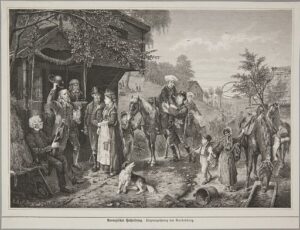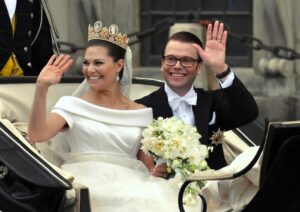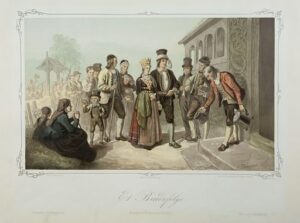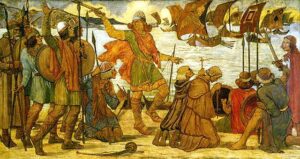Happy Wedding Season!
Here, we’ve collected a round-up of Scandinavian wedding traditions. Let us know if you’ve participated in any of these traditions or plan to for your wedding! See our collection of unique Scandinavian inspired wedding gifts here.

Danish Traditions
In Denmark, there is a traditional custom called the “Gate of Honor” which is an arch of pine branches built in front of the home of the bride’s family. The Gate can be attached to the doorway or somewhere freestanding across the path leading up to the house. The Gate of Honor is erected once again for the couple’s silver anniversary.
During the reception the groom will disappear and all the male guests will come up and kiss the new bride. The female guests will kiss the groom once the bride disappears. Also, the guests will gather around the groom and use scissors to cut his tie and socks. Speeches and songs for the bridal couple are a personal and touching part of the reception.
According to etiquette, the brudevals (the bridal waltz) must be danced before midnight. The guests encircle the couple and clap to the dance steps of the waltz. Closer to the end of the song the guests slowly walk toward the bride and groom giving them less and less dance floor space until there is none.
The Kransekage is the customary wedding cake. The newlyweds cut the cake together and all of the guests must eat a piece, otherwise it is said to bring bad luck to the marriage.

Norwegian Traditions
Norwegian weddings today look similar to those of the U.S. and other European countries. Of course, there are many Norwegian brides and grooms who wear their bunads, national costumes, for the event! Silver and gold sølje jewelry is often worn and Norway also has a traditional bridal crown. Weddings happen both in the church and in a civil ceremony at the city hall. The majority of weddings in Norway are much smaller in size compared to American weddings. The couple will invite those family and friends that are closest to them.
At a traditional Norwegian Wedding Procession, the fiddle players led the way with the bride and groom close behind. Everyone had to make sure they would be in the right place in the procession. After the bride and groom followed their parents, bridesmaids, ring bearer, flower girls and the eager guests came last. The bride would always have the best horse – usually a light colored horse.
Not everyone rode to church. The wedding party could also be on foot, be driven in a carriage or a ferried in a boat. No matter the form of transportation, everyone had to make sure he processed in the correct order. Instead of several bridesmaids and groomsmen as here in the U.S., there will only be one attendant standing on each side of the bride and groom and a flower girl and ring bearer if the couple chooses.
Dinner & Toasts
After the ceremony, a sit-down dinner will follow. The courses can be served to each guest or it may be a smørgåsbord or koldtbord (cold table) where guests can help themselves. Dinners usually last several hours because of the addition of toasts and songs to the bride and groom. This is a wonderful and personal part of the wedding day that is full of both tears and laughter.
The toastmaster will introduce each person who wants to speak. The order of toasts may go as follows: father of the bride, the groom, the bride, maid of honor, best man, groom’s father, bride’s mother, groom’s mother, grandparents/godparents, friends, and finally the “Thank You for the Meal” speech.
Following dinner, the wedding cake may be cut and the guests can help themselves to the variety of cakes and coffee and an after-dinner drink. In Norway, the bride and groom can ask friends and family to supply supplemental cakes for the cake table. Bløtkake, Kransekake, almond cake, cheesecake, and chocolate cakes are among the many and delicious.
The dance will be next on the list with the bride and groom kicking it off. There will be another chance to eat again later once everyone has danced away dinner. The nattmat (night food) menu is much simpler and could consist of sausages, soup with bread, or sandwiches. This way the guests won’t go away hungry in the wee hours of morning.

Swedish Traditions
A Swedish bride of the 19th century wore a black 2-piece dress with a white collar. She also wore a headdress or Bridal Crown, with or without a veil. The groom’s attire consisted of a black suit, white shirt, bow tie and possibly white gloves. The bride usually made her own wedding clothes, which would be considered her most beautiful garments. Sometimes certain garments were passed from one generation to the next. Her ensemble was adorned with decorations such as tissue paper flowers because real flowers were not considered good enough.
Often a Swedish wedding feast lasted for 3 days. The bride wore her hair down for the very last time on her wedding day. Ceremoniously the headdress of a married woman was put on her head during the wedding ceremony. The headdress might be a hat, bonnet or kerchief. A married woman had a higher social status than an unmarried woman and she would be expected to be treated with respect; therefore, women wished to show their social position by wearing the married woman’s headdress.
After coming to America, many Swedish immigrants abandoned the wedding attire of their homeland in favor of the fashions that were popular here at the time. However, the first generation of Swedish-Americans often returned to the old traditions such as wearing the Bridal Crown. Bridal couples in Sweden today wear what we would consider traditional wedding attire: a white dress and tuxedos, just as their wedding celebrations are similar to weddings in other European countries or the USA.

The Lysning
On the Sunday before the wedding, the couple may have a lysning. This dates back to the old tradition of listening to the public announcements in church of a proposed marriage. It is usually a daytime party with a meal and a few drinks. It is traditional to take the couple’s wedding gift to the lysning and not to the church.
On the day of the wedding, the bride’s family welcomes the guests to the church. The couple walks down the aisle together to the altar, and they receive their guests outside of the church following the ceremony.

The Reception
At the reception the couple sits under an arch of flowers. The meal is interrupted often by speeches and songs from family and friends. Celebrations such as weddings call for an elegant smörgåsbord. At a festive smörgåsbord the standard order is to start with fish, followed by meat and the hot dishes and then finish with cheese. Generally, the rules to remember are fish before meat and cold before hot.
In the region of Skåne, dinner might be followed by the towering confection called a spettekaka or spit cake. This meringue-like tradition is created by drizzling the batter – consisting of dozens of beaten eggs, sugar and a bit of potato flour – slowly over a cone-shaped spit rotating over a slow fire. This forms many lacy layers. Spettekakor can reach 2-3 feet and are decorated to suit the occasion. Most are created by professionals.

Viking Wedding Traditions
Much of what is known about old Norse weddings comes from the Icelandic Sagas. Viking weddings were often mostly about exchanges of power. Marriage offered stability, serving as a way to control reproduction in the community. A culture with a negative historical reputation for its treatment of women actually worked quite hard to ensure relative gender equality and fair treatment of and respect for women. For Vikings, marriage wasn’t just a union of the couple, but of families. Because of this, the wedding was a long process. Unions had long-lasting legal implications in Norse culture, affecting everything from familiar property holdings to inheritance. Therefore, numerous negotiations were carried out before the terms of a marriage were formally agreed upon.
At the start of marriage negotiations, the groom’s family, along with legal delegates got together to determine the bride’s dowry, the groom’s financial assets, set the date of the wedding, and negotiate the wedding gift from the groom’s parents. The groom’s family, counsel, and any important local figures to whom they had connections brought proposals to the bride’s family, promising to support and assist them, while agreeing upon mutually beneficial terms for the marriage.
Because marriage was the center of the family in Viking culture, Viking wedding traditions were intricate and complex. Each tradition and ritual was deemed necessary to earn the blessings of the gods, an important step on the path to becoming a parent, and continuing the Viking bloodline.

Honoring Norse Gods
Traditionally, weddings were held on Friday, which in Norse religion is a scared day for Frigga (Freya), the goddess of marriage. Weddings typically lasted a week, and family and friends traveled to the site of the wedding. Winter weddings were impossible because snow rendered travel impractical. Other considerations included appropriate accommodations, acquiring enough food and drink for all guests for the duration of the ceremony, and brewing a special ale drunk by the bride and groom as part of the ceremony. In the lead up to the wedding, Norse brides and grooms were separated so they could strip away their former selves before entering their new lives together.
Symbols of Thor were also often present, like a hammer or axe for the groom.
Rituals
During these rituals, women were attended by their mother, married sisters, and other married female relatives and friends. This includes the stripping of symbols of her “maiden” status, such as her kransen. (A kransen, is a circlet worn in the hair by Scandinavian girls and is a symbol of virginity. The kransen would be stored for the bride’s future daughter.) During the wedding the kransen was replaced with a bridal crown. The bride also cleansed herself in a bathhouse which symbolically washed away a bride’s maiden status away.
Viking brides didn’t wear elaborate costumes or gowns. Rather, the focus was on her hair and crown. A woman’s hair was very important in Viking culture. The bridal-crown that replaced her kransen was typically a family heirloom. These crowns were usually made of silver decorated with crystals and elaborate designs such as crosses and leaves, and draped with silk cords.
A Viking groom presented his ancestral sword to his bride, which she kept for any future sons they might have – boys got swords, girls got virgin headbands. The bride then gave the groom a sword of her ancestors, symbolizing the transfer of a father’s protection of a bride to the husband (much like today’s giving away the bride idea). This exchange was a symbol of sacred union, sanctified by mystic rituals. The bride and groom then exchanged rings to further consecrate the vows, offering rings to one another on the hilt of their new swords.
Shop Scandinavian inspired wedding gifts here!